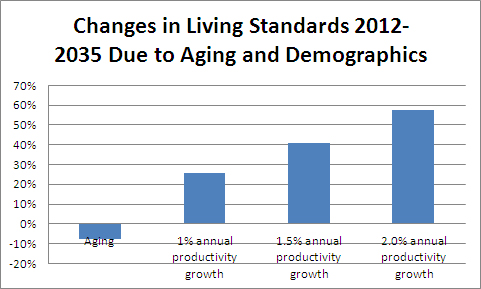August 06, 2012
Ding, ding, ding! Robert Samuelson has just written the 1 millionth piece to appear in the Washington Post claiming that an aging population will undermine our children’s prosperity. He gets awarded a miniature golden baseball bat to symbolize his and the newspapers decades of bashing the elderly and trying to take away their Social Security and Medicare.
Arithmetic fans know that if our children and grandchildren live worse than we do it will be because the folks at the top grabbed away all the money. In any plausible scenario the gains from productivity growth will swamp any additional burdens placed on workers from a larger population of retirees.
The projections that Samuelson cites to make his point in fact demonstrate the opposite. He told readers:
“The ratio of workers to retirees, 5-to-1 in 1960 and 3-to-1 in 2010, is projected at nearly 2-to-1 by 2025.”
Yep, we have had a sharp decline in the ratio of workers to retirees from 1960 to 2010 (most of it by 1990) and yet average living standards rose substantially. This means that there is no reason that average living standards won’t continue to rise in the next several decades as the ratio of workers to retirees falls further.
The simple chart below compares the impact of the projected change in the ratio of workers to retirees on the living standards of workers assuming that an average retiree has 75 percent of the living standard of an average worker. It compares scenarios of 1.0 percent, 1.5 percent and 2.0 percent productivity growth.

Source: Author’s calculation, see text.
As can be seen, the impact of higher productivity growth in raising living standards swamps the impact of demographic change in lowering living standards. It is also important to note that the negative demographic shift ends in 2035. After that point the demographics stabilize or even improve slightly, which means that all future gains in productivity will go into the pockets of our children and grandchildren.
Of course BTP fans everywhere are jumping and down yelling that ordinary workers have not been seeing the gains of productivity growth. Real wages have been nearly stagnant for the last three decades. This is of course right, but that is exactly the point.
If our children and grandchildren do not enjoy substantially higher living standards than we do today, it will not be because they are paying for their parents or grandparents’ Social Security. It will be because the one percent have rigged the economic system so that most of the gains from growth go to the top.
The answer here is not cutting Social Security and Medicare, it is ending too big to fail insurance for huge banks and otherwise cutting a bloated financial system down to size. It is about ending trade and monetary policies that are decided to benefit the rich at the expense of the rest of us. It is about curtailing patent monopolies that has us spending $300 billion a year on drugs that would sell for $30 billion in a competitive market. And it is about fixing a corporate governance system where boards of directors are given 6-figure payoffs to look the other way as top management pillages the company. (See The End of Loser Liberalism: Making Markets Progressive.)
In other words, the real story is not about inter-generational equality, no matter how many times the Post repeats this line. The real story is about intra-generational inequality.







Comments